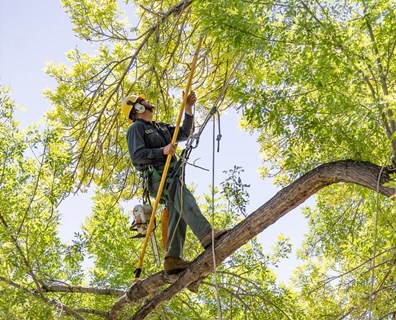Written by Admin and published on https://blog.davey.com/
Pruning, sometimes referred to as trimming, is essentially a horticultural practice of altering a tree’s form. When pruning, you cut away overgrown, diseased, or damaged parts of the tree. These include structurally unstable and unproductive branches, limbs, buds, and even roots. Cutting these parts encourages healthy tree growth.
Landscape trees are not the only things you can prune. You can also prune fruit trees, garden plants, woody plants, shrubs, and more. If carried out properly, pruning can result in ample foliage, flowers, and even fruit. However, if done wrong, you may damage the trees and plants for the long haul. Pruning is a crucial silvicultural and horticultural method that requires in-depth knowledge.
WHAT IS PRUNING? THE IMPORTANCE, BENEFITS AND METHODS OF PRUNING
Topics
- pruning
- how to prune
- pruning benefits
In the forest, trees are free to play by their own rules. They can spread their limbs out, stretch their branches up as high as they’ll grow, and send old, weak limbs down to the forest floor in a freefall.
The trees in our backyards and along our streets don’t have quite as much freedom–and for good reason. Of course, we want our trees to look natural while also ensuring they grow strong and don’t become a safety risk.
…and that’s where pruning comes in! While you may have heard the term and know it has something to do with trimming your trees, read on to learn exactly what pruning is, why we do it and how it’s done.
WHAT YOU NEED TO KNOW ABOUT DIFFERENT TYPES OF PRUNING
WHAT IS THE DEFINITION OF TREE PRUNING?
Pruning is when you selectively remove branches from a tree. The goal is to remove unwanted branches, improve the tree’s structure, and direct new, healthy growth.
WHAT ARE THE BENEFITS OF PRUNING?
Pruning is one of best things you can do for your trees. A proper prune is both an investment in the long-term health of your plants and in the overall look and safety of your property.
When you trim your trees, you get all these benefits!
- Say farewell to dead, broken or damaged branches.
- Save your property from potential damage from fallen branches.
- When you remove old branches, you give trees the green light to put out healthy, new growth.
- Train trees to grow on your terms so that branches won’t hang over the roof or stretch into power lines.
- Give trees a clean, polished look that elevates your whole landscape.
- Set the tree up with a good foundation for long-term health.
WHAT ARE THE DIFFERENT TYPES OR METHODS OF PRUNING?
Different tree goals call for different tree trimming methods.
Here’s a breakdown of the most common types:
- Reducing density removes limbs all the way back to their branch of origin. It’s a method used to free up a full canopy so that more sunlight can come through.
- Maintaining health is like fine-tuning a tree. Simple cuts are used to clear out dead, diseased, and damaged limbs to give the tree a polished look.
- Size management cuts reduce a tree’s height or width. This method typically shortens branches that are inching into utility lines or reduces a wide-spread tree.
- Structural (subordination) cuts could involve one or more of the above methods to improve a plant’s structure and long-term health.
Original post here https://blog.davey.com/2018/09/what-is-pruning-the-importance-benefits-and-methods-of-pruning/.


